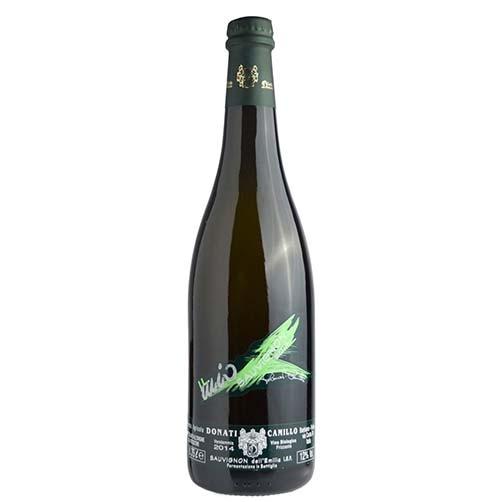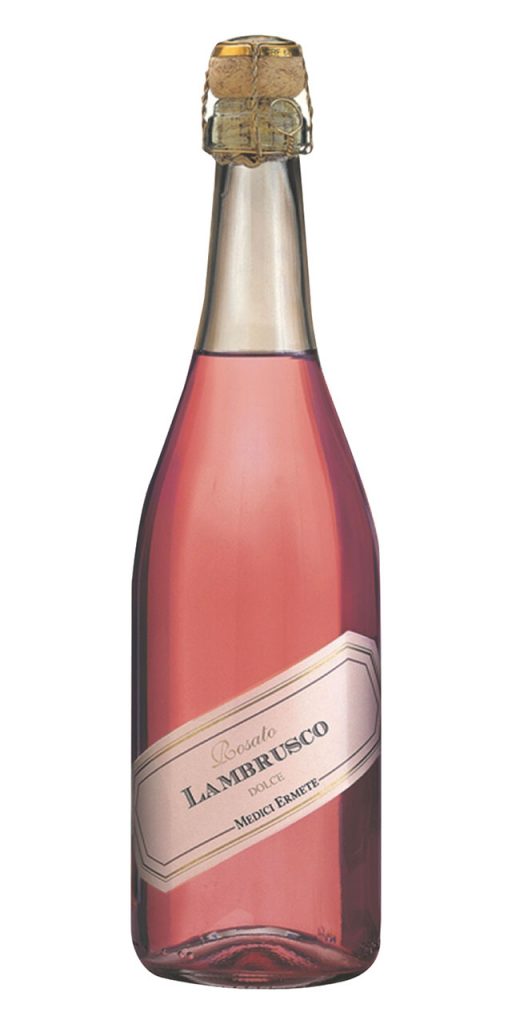Red-hued Bubbly Sure To Make Hearts Beat Faster On Valentine’s Day
Bouquets of roses and boxes of chocolates are red, so why shouldn’t what’s in your flute be too? Skip the brut, blanc de blancs and even rosé this year and celebrate the holiday by popping bottles of sparkling wine that are unabashedly sexy in scarlet.
Sparkling Shiraz
If you’ve never had this wonder from Down Under, the first sip can be quite unexpected. Picture the ripe, juicy, berry flavors, spice notes and soft tannins of Australia’s signature red grape, but chilled and with bubbles. Mark Davidson, head of education for the Americas for Wine Australia, calls sparkling shiraz surprising and delightful--and a great option for February 14. “It’s exciting to be adventurous and try something different, especially if you want to impress your date.” He goes on to add that it can be made using the various methods used for any type of sparkling wine. The charmat method, where the secondary fermentation happens in a closed tank, is common for the more affordable bottles, while highest quality wines are done using the traditional method (the same one used for Champagne, Crémant, Cava and many American bubblies), where it’s bottle-fermented, aged on the lees and left to mature and develop in the bottle. Styles can range from light, fruity and refreshing to fuller-bodied, rich and age-worthy, and as far as food pairings, it’s pretty versatile. “Sparkling shiraz goes surprisingly well with all different types of cuisines,” he points out. “My favorites would be Peking duck, cheese and charcuterie--it’s also a great brunch wine.” If you are searing up some tender filet mignons for your significant other, top them with a red wine reduction and serve it with slightly chilled glasses of these Aussie red bubbles.
Bottles to try:
The Chook Sparkling Shiraz ($15) is a non-vintage wine made from three-year-old shiraz from McLaren Vale and Langhorne Creek, aged in French oak and then blended with younger vintage shiraz. It’s rich, luscious and well-balanced.
Shingleback Black Bubbles ($25) is a fruit-forward and full-bodied wine made with fruit sourced from McLaren Vale. The palate boasts ripe berries, richness and complexity that make it great as an aperitif or throughout an entire meal.
Bleasdale The Red Brute Sparkling Shiraz ($21) is made with premium grapes from Langhorne Creek. The resulting wine touts sweet berry fruit flavors and a great color and depth of flavor.
Lambrusco
Forget about those commercials from the 1980s about how this Italian red fizz is so nice served over ice, and cast aside notions that it’s always sweet, unctuous and simple. Quality Lambrusco is dry and food-friendly--a red wine style you should add to your arsenal. No one champions the grape like Brent Kroll, the partner in Washington, D.C. wine bar Maxwell Park and former wine director for Neighborhood Red Group, a restaurant group whose concepts included the cured meat-focused spot The Partisan. There, Kroll was all too happy to pair rich and fatty salume with these palate-scrubbing bubbles native to four zones in Emilia-Romagna and one in Lombardy. “I wanted to show some respect to a beverage that doesn’t get a lot,” he has said. The wine is generally made from one or a combination of six varieties of lambrusco grapes: grasparossa, maestri, marani, montericco, salamino and sorbara. Sweeter bottles are made by halting fermentation or adding rectified concentrated grape must, while the wine is fermented completely dry for the more serious secco style, which is high in acidity with hints of strawberries and a slightly bitter tannic finish. It gets its bubbles using the charmat or tank method, and resulting bottles are low in acidity (meaning it’ll keep you perky and in the mood, not fuzzy, on that most romantic of evenings.) Kroll points out in its native part of Italy, it’s common to see people walking around noshing on salumi and quaffing cups of Lambrusco, so if you are plating up a charcuterie platter, this should be your go-to.
Bottles to try:
2016 Fiorini, "Terre al Sole" Grasparossa di Castelvetro Lambrusco ($20). “This has serious tannin compared to other Lambruscos and comes from an estate doing a very pristine style,“ Kroll muses. “Its beauty is in the form of purity of fruit with chalk and tannic structure.” Pair it with smoked and rich cured meat like spec or lomo, richly marbled steak like ribeye, or braised meat dishes.
2015 Donati "Il Mio" Lambrusco($22). “This has a sour black fruit and barnyard note, [and] I feel comfortable selling this to a beer geek that drinks sour beer with brett [brettanomyces]. Serve it with a funky, dry-aged New York Strip steak, wild boar pâté or gamey charcuterie.
2010 Cantina della Volta, Lambrusco di Modena($30). “This shows notes or red cherry and citrus with rose petal and slight herbal tones,” Kroll explains. “This is a bottle-fermented Lambrusco highlighting the dry rosé expression of the Sorbara grape.” Sip this medium-bodied rosé Lambrusco alongside pork tenderloin, citrus-cured salumi or rotisserie chicken.
Medici Ermete Lambrusco Emilia Rosato Dolce ($13) For a sweeter take on Lambrusco, this affordable, juicy, luscious rosé (gold medal winner in the 2017 NY International Wine Competition) makes for a striking aperitif with cheese tart, and also makes for a fine match with cheesecake with dessert.
Brachetto d’Acqui / Sparkling Italian Red Blends
Brachetto d’acqui is like a fun, flirty date who’s up for anything. Hailing from Italy’s Piedmont region, these wines are easy-drinking, slightly sweet and slightly effervescent. “It’s wonderfully refreshing, with notes of ripened strawberry and raspberry,” says Jared Gelband, wine director and Cellar in the Sky manager for Italian Village Restaurants in Chicago. “I would compare [it] to a light red version of Moscato d’Asti with a very similar sweetness [but] slightly different fruit notes. (It also evokes comparisons to sweeter styles of Lambrusco.) And while anyone who has ever been served a well-structured, bold glass of cabernet with a truffle or piece of cake can attest, pairing red wine with chocolate can be tricky. Not for Brachetto d’Acqui though, as the residual sugar cozies up nicely with dessert. “Valentine’s Day is a day of sweet food and sweet drinks to share with your loved one, and this is a great way to close out that wonderful evening,” Gelband says. “I would highly recommend pairing it with flourless chocolate cake.” Amanda Herrell, wine director for ENO Wine Room, also in Chicago, recommends it with seared foie gras, especially when it’s served with a strawberry and black pepper gelée. “If you like sweet wine, this is definitely the next one to try.”
There are also some bubbly red wines from Italy that don’t exactly fit into the Brachetto d’Acqui category--which makes them fun and intriguing. Right now, sparkling wines and red blends are both very popular categories of wines,” says Anthony Riboli, winemaker for Riboli Family of San Antonio Winery. “Consumers have shown their affinities for these categories over the last few years, and U.S. sales have grown.” Their thinking is, why not combine the two into a brand new category? The Stella Rosa lineup blends grapes including Brachetto d’Acqui and barbera, sometimes with natural fruit essences, making them perfect with or as a liquid alternative to dessert on Hearts Day.
Bottles to try:
Casalone Mariposa Rosso ($15). “Strawberries for days, and light bubbles to tantalize the palate,” Herrell says.
2013 Marchesi di Barolo Brachetto d’Acqui Gatiè($20). A cherry hue in the glass is joined by aromas of musk and geranium flowers, sweet flavors on the palate, a lively mousse and a soft finish.
Rinaldi Brachetto d’Acqui ($27) is an off-dry wine with a bouquet of strawberries, blackberries and roses, and a great balance between sweetness and fresh acidity.
Stella Rosa Imperiale Rosso Lux ($17) is a blend of barbera and brachetto, and is a bigger wine with more raspberry and dark cherry notes, Riboli says. Try it with grilled salmon or brie topped with poached pears.
Stella Rosa Imperiale Black Lux ($17) is also a blend of barbera and brachetto, to which natural blackberry and blueberry essences are added during fermentation, resulting in a darker color in the bottle and a no brainer when looking for a wine for desserts like berry cobbler topped with vanilla ice cream.





